Pleistocene Calcareous Nannofossil Biostratigraphy and Gephyrocapsid Occurrence in Site U1431D, IODP 349, South China Sea
Abstract
1. Introduction
2. Materials and Methods
2.1. Present Day Circulation of the South China Sea
2.2. Site U1431D
2.3. Calcareous Nannofossil Analysis
3. Results
3.1. Calcareous Nannofossil Biostratigraphy
3.1.1. LO of Discoaster surculus
3.1.2. LO of Discoaster pentaradiatus
3.1.3. Base Acme (BA) of Discoaster triradiatus
3.1.4. LO of Discoaster brouweri
3.1.5. First Occurrence (FO) of Medium Gephyrocapsa spp. (bmG)
3.1.6. LO of Calcidiscus macintyrei
3.1.7. FO of Large Gephyrocapsa spp. (blG)
3.1.8. LO of Large Gephyrocapsa spp. (tlG)
3.1.9. Reentrance Event of Medium Gephyrocapsa spp. (reemG)
3.1.10. FO and LO of Gephyrocapsa sp. 3
3.1.11. LO of Pseudoemiliania lacunosa
3.1.12. FO of Emiliania huxleyi
3.2. Morphologic Changes in Gephyrocapsids in Site U1431D
4. Discussion
4.1. Magnetobiochronologic Calibration of Nannofossil Datums in Site U1431D
4.2. The Importance and Complexity of Gephyrocapsa Morphometry in Site U1431D
4.3. Age–Depth Model for Site U1431D
4.4. Other Possible Nannofossil Events
5. Conclusions
Supplementary Materials
Author Contributions
Funding
Acknowledgments
Conflicts of Interest
Appendix A. Taxonomic Remarks
- Calcidiscus leptoporus (Murray and Blackman, 1989) Loeblich and Tappan, 1978
- Circular to subcircular proximal shield, birefringent. Distal shield non-birefringent with curved sutures. Shields easily separated. Closed central area.
- REMARKS: Species is of little biostratigraphic value for the Pleistocene sediments of Site U1431D.
- Calcidiscus macintyrei (Bukry and Bramlette, 1969a) Loeblich and Tappan, 1978
- Circular proximal shield, birefringent. Distal shield non-birefringent with curved sutures, >10 μm with central opening.
- Ceratolithus cristatus Kamptner, 1950
- Strongly birefringent, c-axis lies in plane of horseshoe, perpendicular to length. Variable in size and degree of ornamentation.
- REMARKS: Species is of little biostratigraphic value for the Pleistocene sediments of Site U1431D.
- Ceratolithus telesmus Norris, 1965
- Strongly birefringent, c-axis lies in plane of horseshoe, perpendicular to length. Long, sinuous arms.
- REMARKS: Species is of little biostratigraphic value for the Pleistocene sediments of Site U1431D.
- Coccolithus pelagicus (Wallich, 1877) Schiller, 1930
- Elliptical placolith; central area open or with simple bar on the proximal surface.
- REMARKS: Specimens of Coccolithus pelagicus with simple bar are only noted from section 10H and below (79.2 mbsf and below). The disappearance of C. pelagicus with bar may be a result of the migration of the species to higher latitudes within the Pleistocene. However, this event was not detected in the samples.
- Cyclicargolithus floridanus (Roth and Hay in Hay et al., 1967) Bukry, 1971a [Coccolithus]
- Coccoliths circular to sub-circular with small central area, <11 μm in width.
- REMARKS: Occurs as reworked specimens.
- Discoaster asymmetricus Gartner, 1969c
- Asymmetric five-rayed variety of D. brouweri.
- REMARKS: Occurs as reworked specimens.
- Discoaster bellus Bukry and Percival, 1971
- Five-rayed discoasters without any central knob or central area development. Straight rays that taper slightly and terminate in points. All rays lie on the same plane.
- REMARKS: Occurs as reworked specimens.
- Discoaster berggrenii Bukry, 1971b
- Symmetric; five-rayed; rays curved; without bifurcations; well-developed central boss; central area 1-2x free ray length; adjacent rays separated at central-area.
- REMARKS: Occurs as reworked specimens.
- Discoaster blackstockae Bukry, 1973
- four-rayed form with inter-ray angles of 60° and 120°. Considered a variant of D. brouweri.
- REMARKS: Distribution within the core is very limited and does not parallel that of D. brouweri.
- Discoaster brouweri Tan, 1927b emend. Bramlette and Riedel, 1954
- Ray tips non-bifurcate but with marked proximal extensions giving it a distinctive concavo-convex form; six-rayed asterolith species.
- Discoaster calcaris Gartner, 1967
- Six-rayed asterolith, bifurcating asymmetrically at tip. Longer branch of bifurcation curved sharply proximally but extending only slightly laterally beyond tip of ray.
- REMARKS: Occurs as reworked specimens.
- Discoaster kugleri Martini and Bramette, 1963
- Central-area wide and flat; free rays short with notched ends rather than true bifurcations.
- REMARKS: Occurs as reworked specimens.
- Discoaster pentaradiatus Tan, 1927b
- Five-rayed acute bifurcations; strongly concavo-convex and birefringent (each ray is a separate unit, with c-axes inclined slightly from vertical toward radial).
- REMARKS: The distribution of D. pentaradiatus is sporadic in Site U1431D sediments, thus the LO of the species was not used for biostratigraphy.
- Discoaster quinqueramus Gartner, 1969c
- Five-rayed with concavo-convex rays. Central area with prominent distal sutural ridges and large proximal boss.
- REMARKS: Occurs as reworked specimens.
- Discoaster surculus Martini and Bramlette, 1963
- Six-rayed and rarely with fewer rays with a stellate knob in the central area. From the knob, small ridges extend to the margin between the rays on one side of the asterolith and along the arms on the side. The slender rays are slightly enlarged at the end, and show a trifurcation, with the central spine extending beyond the arms.
- Discoaster tamalis Kamptner, 1967
- Concavo-convex rays. Calcite body consists of four arms arranged to form an orthogonal cross. There is no boss in the central area.
- REMARKS: Occurs as reworked specimens.
- Discoaster triradiatus Tan, 1927b
- Symmetric three-rayed variety of D. brouweri.
- Discoaster variabilis Martini and Bramlette, 1963
- Central-area with proximal and distal ridges but weak bosses. Bifurcations well developed.
- REMARKS: Occurs as reworked specimens.
- Emiliania huxleyi (Lohmann, 1902) Hay and Mohler in Hay et al., 1967
- No bridge, slits between distal shield elements.
- Florisphaera profunda Okada and Honjo, 1973
- Coccoliths formed of single angular 5-sided calcite units.
- REMARKS: Species is of little biostratigraphic value for the Pleistocene sediments of Site U1431D.
- Gephyrocapsa Kamptner, 1943
- Like Reticulofenestra but with bridge formed from inner tube.
- REMARKS: Size differences of coccoliths are used to separate the genus into different morphotypes for biostratigraphic purposes. The size criteria assigned by [21] is adopted in this study.
- Gephyrocapsa sp. 3 Rio, 1982 (synonym: G. parallela Hay and Beaudry, 1973)
- Large (4.0–6.4 μm) circular to sub-circular placolith, open central-area spanned by a bridge aligned 60°–90° to the long axis.
- REMARKS: In this study, only those with a bridge aligned at 85°–90° to the long axis are considered as Gephyrocapsa sp. 3.
- Helicosphaera carteri (Wallich, 1877) Kamptner, 1954
- Medium to large size; flange ends in wing; two pores in central-area.
- REMARKS: Species is of little biostratigraphic value for the Pleistocene sediments of Site U1431D.
- Helicosphaera carteri var. wallichi (Lohmann, 1902) Theodoridis, 1984 [H. wallichi]
- Like H. carteri but central-area with inclined pores.
- REMARKS: Species is of little biostratigraphic value for the Pleistocene sediments of Site U1431D.
- Helicosphaera inversa (Gartner, 1977 ex Gartner, 1980) Theodoridis, 1984
- Like H. carteri but with large pores separated by prominent conjunct sub-horizontal bar usually with inverse direction.
- REMARKS: Only one specimen of H. inversa is seen in Site U1431D samples; thus, it is not utilized for biostratigraphy.
- Helicosphaera sellii (Bukry and Bramlette, 1969a) Jafar and Martini, 1975 [Helicopontosphaera]
- Like H. carteri but pores large.
- REMARKS: Distribution is sporadic in Site U1431D samples; thus, it is not utilized for biostratigraphy.
- Neosphaera coccolithomorpha Lecal-Schaluder, 1950
- Circular, ring-shaped coccoliths with open central-area. Single shield and tube, no distal shield. Superficially similar in light microscope to Umbilicosphaera rotula but shield paler in phase contrast and distinctive pseudoextinction cross seen in cross-polars at high focus.
- REMARKS: Species is of little biostratigraphic value for the Pleistocene sediments of Site U1431D.
- Pseudoemiliania lacunosa (Kamptner 1963) Gartner, 1969 [Ellipsoplacolithus]
- Circular to broadly elliptical with variable number of slits in distal shield. Abundant in late Pliocene but well-developed, large circular forms occur only in the Pleistocene.
- REMARKS: [84] observed that circular forms became much abundant during the late Pleistocene. However, circular forms are more abundant in the early Pleistocene in samples from Site U1431D.
- Reticulofenestra minuta Roth, 1970
- <3 μm which probably includes several different species.
- REMARKS: Species is of little biostratigraphic value for the Pleistocene sediments of Site U1431D.
- Reticulofenestra haqii Backman, 1978
- 3–5 μm which intergrades with R. pseudoumbilicus.
- REMARKS: Species is of little biostratigraphic value for the Pleistocene sediments of Site U1431D.
- Reticulofenestra pseudoumbilicus (Gartner, 1967b) Gartner, 1969c [Coccolithus]
- >5 μm but for biostratigraphy it is better to separate the >7 μm specimens.
- REMARKS: Occurs as reworked specimens.
- Rhabdosphaera clavigera Murray and Blackman, 1898
- Robust, club-shaped, 7–10 μm long.
- REMARKS: Species is of little biostratigraphic value for the Pleistocene sediments of Site U1431D.
- Scyphosphaera Lohmann, 1902
- Vase-like coccoliths, generally large.
- REMARKS: Species is of little biostratigraphic value.
- Sphenolithus abies Deflandre in Deflandre and Fert, 1954
- Similar to S. moriformis but more elevated and with cuspate outline.
- REMARKS: Occurs as reworked specimens.
- Sphenolithus moriformis (Brönnimann and Stradner, 1960) Bramlette and Wilcoxon, 1967a (Nannoturbella)
- Generalized form, no spine, upper and lower parts of similar size.
- REMARKS: Occurs as reworked specimens.
- Syracosphaera histrica Kamptner, 1941
- Oblong or irregularly elliptical with bright rim and central-area.
- REMARKS: Species is of little biostratigraphic value for the Pleistocene sediments of Site U1431D.
- Umbellosphaera tenuis (Kamptner, 1937) Paasche in Markali and Paasche, 1955 [Coccolithus]
- Trumpet-shaped coccoliths, with ridges on the distal surface
- REMARKS: Species is of little biostratigraphic value for the Pleistocene sediments of Site U1431D.
- Umbilicosphaera sibogae var. sibogae (Weber-van Bosse, 1901) Gaarder, 1970 [Coccosphaera]
- Central opening wide, proximal shield monocyclic, wider than the distal shield.
- REMARKS: Species is of little biostratigraphic value for the Pleistocene sediments of Site U1431D.
References
- Shackleton, N.J.; Berger, A.; Peltier, W.R. An alternative astronomical calibration of the lower Pleistocene timescale based on ODP Site 677. Trans. R. Soc. Edinb. Earth Sci. 1990, 81, 251–261. [Google Scholar] [CrossRef]
- Lisiecki, L.E.; Raymo, M.E. A Pliocene-Pleistocene stack of 57 globally distributed benthic δ18O records. Paleoceanography 2005, 20, 1–17. [Google Scholar] [CrossRef]
- de Boer, B.; Lourens, L.J.; van de Wal, R.S.W. Persistent 400,000-year variability of Antarctic ice volume and the carbon cycle is revealed throughout the Plio-Pleistocene. Nat. Commun. 2014, 5, 2999. [Google Scholar] [CrossRef] [PubMed]
- Loutre, M.F.; Berger, A. Marine Isotope Stage 11 as an analogue for the present interglacial. Glob. Planet. Chang. 2003, 36, 209–217. [Google Scholar] [CrossRef]
- Dickson, A.J.; Beer, C.J.; Dempsey, C.; Maslin, M.A.; Bendle, J.A.; McClymont, E.L.; Pancost, R.D. Oceanic forcing of the Marine Isotope Stage 11 interglacial. Nat. Geosci. 2009, 2, 428–433. [Google Scholar] [CrossRef]
- Bown, P.R.; Young, J.R. Introduction. In Calcareous Nannofossil Biostratigraphy; British Micropalaeontological Society Publication Series; Chapman and Hall (Kluwer Academic Publishers): London, UK, 1998; pp. 1–15. [Google Scholar]
- Raffi, I.; Backman, J.; Fornaciari, E.; Pälike, H.; Rio, D.; Lourens, L.; Hilgen, F. A review of calcareous nannofossil astrobiochronology encompassing the past 25 million years. Quat. Sci. Rev. 2006, 25, 3113–3137. [Google Scholar] [CrossRef]
- Backman, J.; Raffi, I.; Rio, D.; Fornaciari, E.; Pälike, H. Biozonation and biochronology of Miocene through Pleistocene calcareous nannofossils from low and middle latitudes. Newsl. Stratigr. 2012, 45, 221–244. [Google Scholar] [CrossRef]
- Gradstein, F.; Ogg, J.; Schmitz, M.; Ogg, G. The Geologic Time Scale 2012, 1st ed.; Elsevier BV: Amsterdam, The Netherlands, 2012. [Google Scholar]
- Chepstow-Lusty, A.; Backman, J.; Shackleton, N.J. Comparison of upper Pliocene Discoaster abundance variations from North Atlantic sites 552, 607, 658, 659, 662; further evidence for marine plankton responding to orbital forcing. Proc. Ocean. Drill. Program. Sci. Results 1989, 108, 121–141. [Google Scholar]
- Chepstow-Lusty, A.; Backman, J.; Shackleton, N.J. Palaeoclimatic control of upper Pliocene Discoaster assemblages in the North Atlantic. J. Micropalaeontol. 1991, 9, 133–143. [Google Scholar] [CrossRef]
- Chepstow-Lusty, A.J.; Chapman, M.R. The decline and extinction of Upper Pliocene Discoasters: A comparison of two equatorial Pacific Ocean records. J. Nannoplankton Res. 1995, 17, 15–19. [Google Scholar]
- Chapman, M.R.; Chepstow-Lusty, A.J. Late Pliocene climatic change and the global extinction of the discoasters: An independent assessment using oxygen isotope records. Palaeogeogr. Palaeoclimatol. Palaeoecol. 1997, 134, 109–125. [Google Scholar] [CrossRef]
- Tangunan, D.N.; Baumann, K.-H.; Just, J.; LeVay, L.J.; Barker, S.; Brentegani, L.; De Vleeschouwer, D.; Hall, I.R.; Hemming, S.; Norris, R. The last 1 million years of the extinct genus Discoaster: Plio–Pleistocene environment and productivity at Site U1476 (Mozambique Channel). Palaeogeogr. Palaeoclimatol. Palaeoecol. 2018, 505, 187–197. [Google Scholar] [CrossRef]
- Gartner, S. Late Pleistocene calcareous nannofossils in the caribbean and their interoceanic correlation. Palaeogeogr. Palaeoclimatol. Palaeoecol. 1972, 12, 169–191. [Google Scholar] [CrossRef]
- Gartner, S. Calcareous nannofossil biostratigraphy and revised zonation of the Pleistocene. Mar. Micropaleontol. 1977, 2, 1–25. [Google Scholar] [CrossRef]
- Thierstein, H.R.; Geitzenauer, K.R.; Molfino, B.; Shackleton, N.J. Global synchroneity of late Quaternary coccolith datum levels: Validation by oxygen isotopes. Geology 1977, 6, 400–404. [Google Scholar] [CrossRef]
- Samtleben, C. Die evolution der Coccolithophoriden-gattung Gephyrocapsa nach befunden im Atlantik. Paläontol. Z. 1980, 54, 91–127. [Google Scholar] [CrossRef]
- Rio, D. The fossil distribution of coccolithophore genus Gephyrocapsa Kamptner and related Plio-Pleistocene chronostratigraphic problems. Initial Rep. Deep Sea Drill. Proj. 1982, 68, 325–343. [Google Scholar]
- Rio, D.; Raffi, I.; Villa, G. Pliocene-Pleistocene calcareous nannofossil distribution patterns in the western Mediterranean. Proc. Ocean. Drill. Program. Sci. Results 1990, 107, 513–533. [Google Scholar]
- Raffi, I.; Backman, J.; Rio, D.; Shackleton, N.J. Plio-Pleistocene nannofossil biostratigraphy and calibration to oxygen isotope stratigraphies from Deep Sea Drilling Project Site 607 and Ocean Drilling Program Site 677. Paleoceanography 1993, 8, 387–408. [Google Scholar] [CrossRef]
- Wei, W. Calibration of Upper Pliocene-Lower Pleistocene nannofossil events with oxygen isotope stratigraphy. Paleoceanography 1993, 8, 85–99. [Google Scholar] [CrossRef]
- Matsuoka, H.; Okada, H. Quantitative analysis of Quaternary nannoplankton in the subtropical northwestern Pacific Ocean. Mar. Micropaleontol. 1989, 14, 97–118. [Google Scholar] [CrossRef]
- Matsuoka, H.; Okada, H. Time-progressive morphometric changes of the genus Gephyrocapsa in the Quaternary sequence of the tropical Indian Ocean, Site 709. Proc. Ocean Drill. Program. Sci. Results 1990, 115, 255–270. [Google Scholar]
- Wei, K.-Y.; Yang, T.-N.; Huang, C.-Y. Glacial-Holocene calcareous nannofossils and paleoceanography in the northern South China Sea. Mar. Micropaleontol. 1997, 32, 95–114. [Google Scholar] [CrossRef]
- Jian, Z.; Wang, L.; Kienast, M.; Sarnthein, M.; Kuhnt, W.; Lin, H.; Wang, P. Benthic foraminiferal paleoceanography of the South China Sea over the last 40,000 years. Mar. Geol. 1999, 156, 159–186. [Google Scholar] [CrossRef]
- Wang, P. Response of Western Pacific marginal seas to glacial cycles: Paleoceanographic and sedimentological features. Mar. Geol. 1999, 156, 5–39. [Google Scholar] [CrossRef]
- Nathan, S.A.; Leckie, R.M. Miocene planktonic foraminiferal biostratigraphy of Sites 1143 and 1146, ODP Leg 184, South China Sea. Proc. Ocean Drill. Program. Sci. Results 2003, 184, 1–43. [Google Scholar]
- Li, B.; Jian, Z.; Li, Q.; Tian, J.; Wang, P. Paleoceanography of the South China Sea since the middle Miocene: Evidence from planktonic foraminifera. Mar. Micropaleontol. 2005, 54, 49–62. [Google Scholar] [CrossRef]
- Su, X.; Liu, C.; Beaufort, L.; Tian, J.; Huang, E. Late Quaternary coccolith records in the South China Sea and East Asian monsoon dynamics. Glob. Planet. Chang. 2013, 111, 88–96. [Google Scholar] [CrossRef]
- Lüdmann, T.; Kin Wong, H.; Wang, P. Plio–Quaternary sedimentation processes and neotectonics of the northern continental margin of the South China Sea. Mar. Geol. 2001, 172, 331–358. [Google Scholar] [CrossRef]
- Liu, Z.; Colin, C.; Huang, W.; Le, K.P.; Tong, S.; Chen, Z.; Trentesaux, A. Climatic and tectonic controls on weathering in south China and Indochina Peninsula: Clay mineralogical and geochemical investigations from the Pearl, Red, and Mekong drainage basins. Geochem. Geophys. Geosyst. 2007, 8, 1–18. [Google Scholar] [CrossRef]
- Wan, S.; Li, A.; Clift, P.D.; Stuut, J.-B.W. Development of the East Asian monsoon: Mineralogical and sedimentologic records in the northern South China Sea since 20 Ma. Palaeogeogr. Palaeoclimatol. Palaeoecol. 2007, 254, 561–582. [Google Scholar] [CrossRef]
- Zong, Y.; Huang, G.; Li, X.Y.; Sun, Y.Y. Late Quaternary tectonics, sea-level change and lithostratigraphy along the northern coast of the South China Sea. In River-Dominated Shelf Sediments of East Asian Seas; Clift, P.D., Harff, J., Wu, J., Yan, Q., Eds.; Geological Society, Special Publications: London, UK, 2015; pp. 123–136. [Google Scholar]
- Wang, P.; Li, Q.; Tian, J.; Jian, Z.; Liu, C.; Li, L.; Ma, W. Long-term cycles in the carbon reservoir of the Quaternary ocean: A perspective from the South China Sea. Natl. Sci. Rev. 2014, 1, 119–143. [Google Scholar] [CrossRef]
- Cheng, X. Calcareous nannofossils in surface sediments of the central and northern parts of the South China Sea. J. Micropalaeontol. 1992, 11, 167–176. [Google Scholar] [CrossRef]
- Cheng, X.; Wang, P. Controlling factors of coccolith distribution in surface sediments of the China seas: Marginal sea nannofossil assemblages revisited. Mar. Micropaleontol. 1997, 32, 155–172. [Google Scholar] [CrossRef]
- Fernando, A.G.S.; Peleo-Alampay, A.M.; Lucero, E.S.; Wiesner, M.G. Surface sediment distribution of Florisphaera profunda in the South China Sea: An effect of dissolution? J. Nannoplankton Res. 2007, 29, 102–107. [Google Scholar]
- Fernando, A.G.S.; Peleo-Alampay, A.M.; Wiesner, M.G. Calcareous nannofossils in surface sediments of the eastern and western South China Sea. Mar. Micropaleontol. 2007, 66, 1–26. [Google Scholar] [CrossRef]
- Weiwu, D.; Yongyang, H. Tertiary calcareous nannofossil biostratigraphy in the north part of the South China Sea. Acta Geol. Sin. Engl. Ed. 1991, 4, 321–339. [Google Scholar] [CrossRef]
- Huang, L. Calcareous nannofossil biostratigraphy in the Pearl River Mouth Basin, South China Sea, and Neogene reticulofenestrid coccoliths size distribution pattern. Mar. Micropaleontol. 1997, 32, 31–57. [Google Scholar] [CrossRef]
- Su, X.; Xu, Y.; Tu, Q. Early Oligocene-Pleistocene calcareous nannofossil biostratigraphy of the northern South China Sea (Leg 184, Sites 1146–1148). In Proceedings of the Ocean Drilling Program: Scientific Results; Prell, W.L., Wang, P., Blum, P., Rea, D.K., Clemens, S.C., Eds.; Texas A&M University: College Station, TX, USA, 2004; Volume 184, pp. 1–24. ISBN 08845891. [Google Scholar]
- Li, C.; Lin, J.; Kulhanek, D.K.; Williams, T.; Bao, R.; Briais, A.; Brown, E.A.; Yifeng, C.; Clift, P.D.; Colwell, F.S.; et al. Site U1431. Proc. Int. Ocean. Discov. Program. 2014, 349, 1–54. [Google Scholar]
- Li, C.-F.; Lin, J.; Kulhanek, D.K. South China Sea tectonics; opening of the South China Sea and its implications for southeast Asian tectonics, climates, and deep mantle processes since the late Mesozoic. In International Ocean Discovery Program Expedition 349 Scientific Prospectus; IODP Management International: College Station, TX, USA, 2013. [Google Scholar]
- Xie, S.-P.; Xie, Q.; Wang, D.; Liu, W.T. Summer upwelling in the South China Sea and its role in regional climate variations. J. Geophys. Res. Ocean. 2003, 108. [Google Scholar] [CrossRef]
- The South. China Sea: Paleoceanography and Sedimentology; Wang, P., Li, Q., Eds.; Developments in Paleoenvironmental Research; Springer: Dordrecht, The Netherlands, 2009; Volune 13, ISBN 978-1-4020-9744-7. [Google Scholar]
- Bown, P.R.; Young, J.R. Techniques. In Calcareous Nannofossil Biostratigraphy; British Micropalaeontological Society Publication Series; Chapman and Hall (Kluwer Academic Publishers): London, UK, 1998; pp. 16–28. [Google Scholar]
- Perch-Nielsen, K. Cenozoic calcareous nannofossils. In Plankton Stratigraphy; Bolli, H.M., Saunders, J.M., Perch-Nielsen, K., Eds.; Cambridge University Press: Cambridge, UK, 1985; pp. 427–554. [Google Scholar]
- Aubry, M.-P. Handbook of Cenozoic Calcareous Nannoplankton, Book 1: Ortholithae (Discoasters); American Museum of Natural History; Micropaleontology Press: Flushing, NY, USA, 1984. [Google Scholar]
- Aubry, M.-P. Handbook of Cenozoic Calcareous Nannoplankton, Book 4: Heliolithae (Helicoliths, Cribriliths, Lopadoliths and Others); American Museum of Natural History; Micropaleontology Press: Flushing, NY, USA, 1990. [Google Scholar]
- Backman, J.; Shackleton, N.J. Quantitative biochronology of Pliocene and early Pleistocene calcareous nannofossils from the Atlantic, Indian and Pacific oceans. Mar. Micropaleontol. 1983, 8, 141–170. [Google Scholar] [CrossRef]
- Bollmann, J. Morphology and biogeography of Gephyrocapsa coccoliths in Holocene sediments. Mar. Micropaleontol. 1997, 29, 319–350. [Google Scholar] [CrossRef]
- Liu, L.; Maiorano, P.; Zhao, X. Pliocene-Pleistocene calcareous nannofossils from the Iberia abyssal plain. Proc. Ocean Drill. Program. Sci. Results 1996, 149, 147–164. [Google Scholar]
- Marino, M.; Maiorano, P.; Monechif, S. Quantitative Pleistocene calcareous nannofossil biostratigraphy of Leg 86, Site 577 (Shatsky Rise, NW Pacific Ocean). J. Nannoplankton Res. 2003, 25, 25–37. [Google Scholar]
- Houghton, S.D. Late Neogene calcareous nannofossil biostratigraphy and paleoceanography of ODP Hole 677A, Panama Basin. Proc. Ocean. Drill. Program. Sci. Results 1989, 111, 277–285. [Google Scholar]
- Raffi, I.; Flores, J.-A. Pleistocene through Miocene calcareous nannofossils from eastern Equatorial Pacific Ocean (Leg 138). Proc. Ocean. Drill. Program. Sci. Results 1995, 138, 233–282. [Google Scholar]
- Kameo, K.; Bralower, T.J. Neogene calcareous nannofossil biostratigraphy of sites 998, 999, and 1000, Caribbean Sea. Proc. Ocean. Drill. Program. Sci. Results 2000, 165, 3–17. [Google Scholar]
- Curry, W.B.; Shackleton, N.J.; Richter, C.; Backman, J.E.; Bassinot, F.; Bickert, T.; Chaisson, W.P.; Cullen, J.L.; deMenocal, P.; Dobson, D.M.; et al. Site 925. Proc. Ocean. Drill. Program. Part. Initial Rep. 1995, 154, 55–152. [Google Scholar]
- Lupi, C.; Bordiga, M.; Cobianchi, M. Gephyrocapsa occurrence during the Middle Pleistocene transition in the Northern Pacific Ocean (Shatsky Rise). Geobios 2012, 45, 209–217. [Google Scholar] [CrossRef]
- de Kaenel, E.P.; Siesser, W.G.; Murat, A. Pleistocene calcareous nannofossil biostratigraphy and the western Mediterranean sapropels, sites 974 to 977 and 979. Proc. Ocean. Drill. Program. Sci. Results 1999, 161, 159–183. [Google Scholar]
- Lourens, L.J.; Hilgen, F.J.; Shackleton, N.J.; Laskar, J.; Wilson, D. The Neogene Period. In A Geologic Time Scale 2004; Gradstein, F., Ogg, J., Smith, A., Eds.; Cambridge University Press: New York, NY, USA, 2004; pp. 409–440. [Google Scholar]
- Roberts, D.G.; Schnitker, D.; Baldauf, J.G.; Desprairies, A.; Homrighausen, R.; Huddlestun, P.F.; Kaltenback, A.J.; Krumsiek, K.A.O.; Morton, A.C.; Murray, J.W.; et al. Sites 552–553. Initial Rep. Deep Sea Drill. Proj. 1984, 81, 31. [Google Scholar]
- Ruddiman, W.F.; Kidd, R.B.; Baldauf, J.G.; Clement, B.M.; Dolan, J.F.; Eggers, M.R.; Hill, P.R.; Keigwin, L.D., Jr.; Mitchell, M.; Philipps, I.; et al. Site 607. Initial Rep. Deep Sea Drill. Proj. 1987, 94, 75. [Google Scholar]
- Sprovieri, R.; Di Stefano, E.; Howell, M.; Sakamoto, T.; Di Stefano, A.; Marino, M. Integrated calcareous plankton biostratigraphy and cyclostratigraphy at Site 964. Proc. Ocean. Drill. Program. Sci. Results 1998, 160, 155–166. [Google Scholar]
- Kameo, K.; Okada, M. Calcareous nannofossil biochronology from the upper Pliocene to lower Pleistocene in the southernmost Boso Peninsula, central part of the Pacific side of Japan. J. Asian Earth Sci. 2016, 129, 142–151. [Google Scholar] [CrossRef]
- Wu, H.; Zhao, X.; Shi, M.; Zhang, S.; Li, H.; Yang, T. A 23 Myr magnetostratigraphic time framework for Site 1148, ODP Leg 184 in South China Sea and its geological implications. Mar. Pet. Geol. 2014, 58, 749–759. [Google Scholar] [CrossRef]
- Shyu, J.-P.; Merrill, D.L.; Hsü, V.; Kaminski, M.A.; Müller, C.M.; Nederbragt, A.J.; Scherer, R.P.; Shibuya, H. Biostratigraphic and magnetostratigraphic synthesis of the Celebes and Sulu Seas, Leg 124. Proc. Ocean. Drill. Program. Sci. Results 1991, 124, 11–35. [Google Scholar]
- Mayer, L.A.; Pisias, N.G.; Janecek, T.R.; Baldauf, J.G.; Bloomer, S.F.; Dadey, K.A.; Emeis, K.-C.; Farrell, J.; Flores, J.A.; Galimov, E.M.; et al. Site 846. Proc. Ocean. Drill. Program. Part. Initial Rep. 1991, 138, 265. [Google Scholar]
- Backman, J.; Duncan, R.A.; Peterson, L.C.; Baker, P.A.; Baxter, A.N.; Boersma, A.; Cullen, J.L.; Droxler, A.W.; Fisk, M.R.; Greenough, J.D.; et al. Site 710. Proc. Ocean. Drill. Program. Part. Initial Rep. 1988, 115, 589. [Google Scholar]
- Barton, C.E.; Bloemendal, J. Paleomagnetism of sediments collected during Leg 90, southwest Pacific (DSDP). In Initial Reports of Deep Sea Drilling Program; Texas A & M University, Ocean Drilling Program: College Station, TX, USA, 1986; Volume 90, pp. 1273–1316. [Google Scholar]
- Lohman, W.H. Calcareous nannoplankton biostratigraphy of the southern Coral Sea, Tasman Sea, and southwestern Pacific Ocean, Deep Sea Drilling Project Leg 90: Neogene and Quaternary. In Initial Reports of the Deep Sea Drilling Project; Texas A & M University, Ocean Drilling Program: College Station, TX, USA, 1986; Volume 90. [Google Scholar]
- Bickert, T.; Curry, W.B.; Wefer, G. Late Pliocene to Holocene (2.6-0 Ma) western Equatorial Atlantic deep-water circulation; inferences from benthic stable isotopes. Proc. Ocean. Drill. Program. Sci. Results 1997, 154, 239–254. [Google Scholar]
- Takayama, T.; Sato, T. Coccolith biostratigraphy of the North Atlantic Ocean, Deep Sea Drilling Project Leg 94. Initial Rep. Deep Sea Drill. Proj. 1987, 94, 651–702. [Google Scholar]
- Martini, E. Standard Tertiary and Quaternary Calcareous Nannoplankton Zonation; Farinacci, A., Ed.; Tecnoscienza: Rome, Italy, 1971; pp. 739–785. [Google Scholar]
- Muza, J.P. Calcareous nannofossil biostratigraphy from the Japan Sea, sites 798 and 799; evidence for an oscillating Pleistocene oceanographic frontal boundary. Proc. Ocean. Drill. Program. Sci. Results 1992, 127, 155–169. [Google Scholar]
- Castradori, D. Calcareous nannofossil biostratigraphy and biochronology in Eastern Mediterranean deep-sea cores. Riv. Ital. Paleontol. E Stratigr. 1993, 99, 107–126. [Google Scholar]
- Maiorano, P.; Marino, M. Calcareous nannofossil bioevents and environmental control on temporal and spatial patterns at the early–middle Pleistocene. Mar. Micropaleontol. 2004, 53, 405–422. [Google Scholar] [CrossRef]
- Geitzenauer, K. The Pleistocene calcareous nannoplankton of the subantarctic Pacific Ocean. Deep Sea Res. 1972, 19, 45–60. [Google Scholar] [CrossRef]
- Di Stefano, E.; Caracausi, S.; Incarbona, A.; Velardi, S. Size variations in the genus Gephyrocapsa during the Early Pleistocene in the eastern Mediterranean. Ital. J. Geosci. 2014, 133, 474–480. [Google Scholar] [CrossRef]
- McIntyre, A.; Bé, A.W.H.; Roche, M.B. Modern Pacific Coccolithophorida: A paleontological thermometer. Trans. N. Y. Acad. Sci. 1970, 32, 720–731. [Google Scholar] [CrossRef]
- Raffi, I. Revision of the early-middle Pleistocene calcareous nannofossil biochronology (1.75–0.85 Ma). Mar. Micropaleontol. 2020, 45, 25–55. [Google Scholar] [CrossRef]
- Maiorano, P.; Marino, M.; Di Stefano, E.; Ciaranfi, N. Calcareous nannofossil events in the Lower-Mildle Pleistocene transition at the Montalbano Jonico section and ODP site 964: Calibration with isotope and sapropel stratigraphy. Riv. Ital. Paleontol. E Stratigr. 2004, 110, 547–557. [Google Scholar]
- Marino, M.; Maiorano, P.; Flower, B.P. Calcareous nannofossil changes during the Mid-Pleistocene Revolution: Paleoecologic and paleoceanographic evidence from North Atlantic Site 980/981. Palaeogeogr. Palaeoclimatol. Palaeoecol. 2011, 306, 58–69. [Google Scholar] [CrossRef]
- Hay, W.W. Calcareous nannofossils from cores recovered on Leg 4. Initial Rep. Deep Sea Drill. Proj. 1970, 4, 455–501. [Google Scholar]
- Hine, N.; Weaver, P.P.E. Quaternary. In Calcareous Nannofossil Biostratigraphy; British Micropalaeontological Society Publication Series; Chapman and Hall (Kluwer Academic Publishers): London, UK, 1998; pp. 266–283. [Google Scholar]
- Young, J.R. A Quaternary nannofossil range chart. Int. Nannoplankton Assoc. Newsl. 1991, 13, 14–17. [Google Scholar]

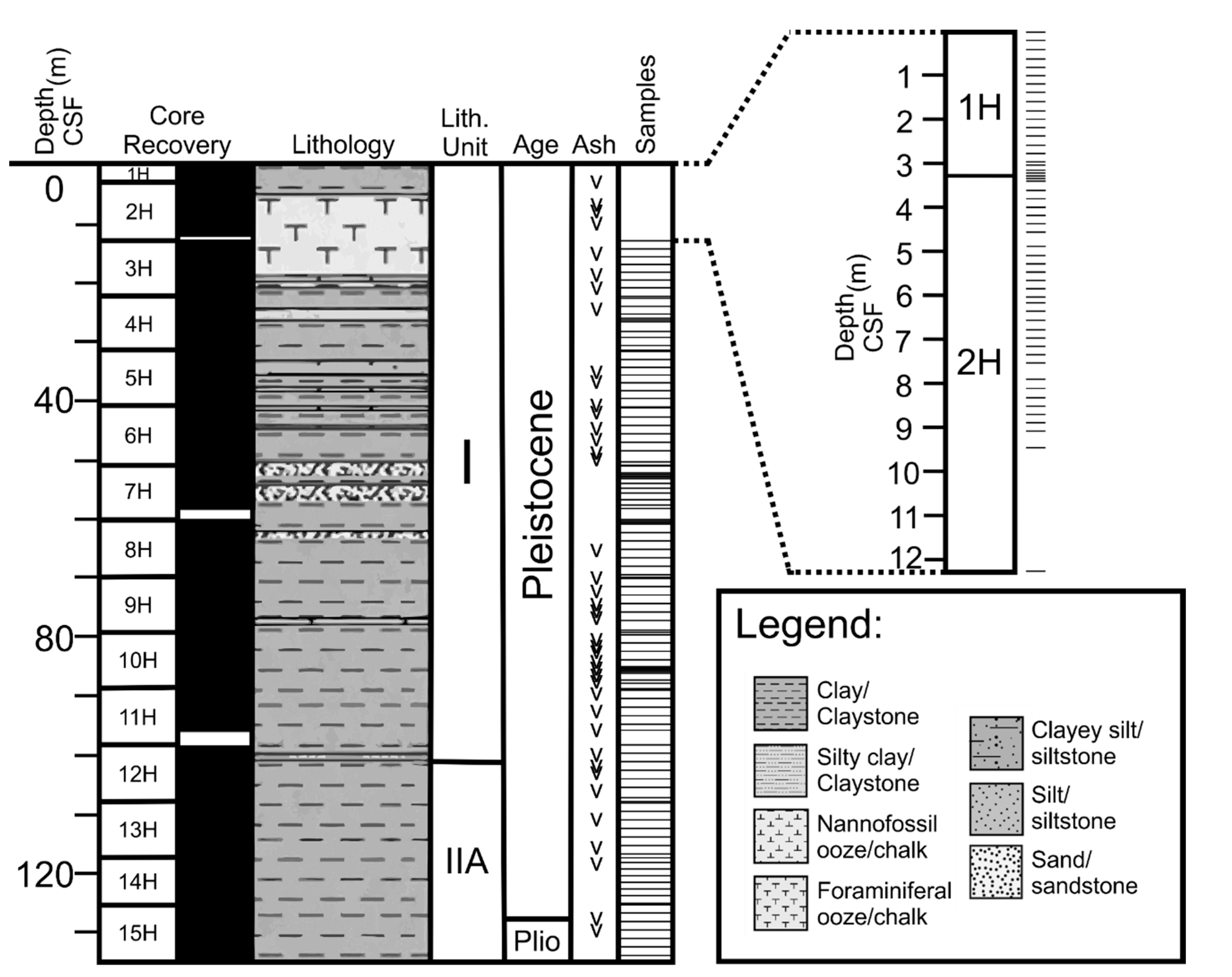

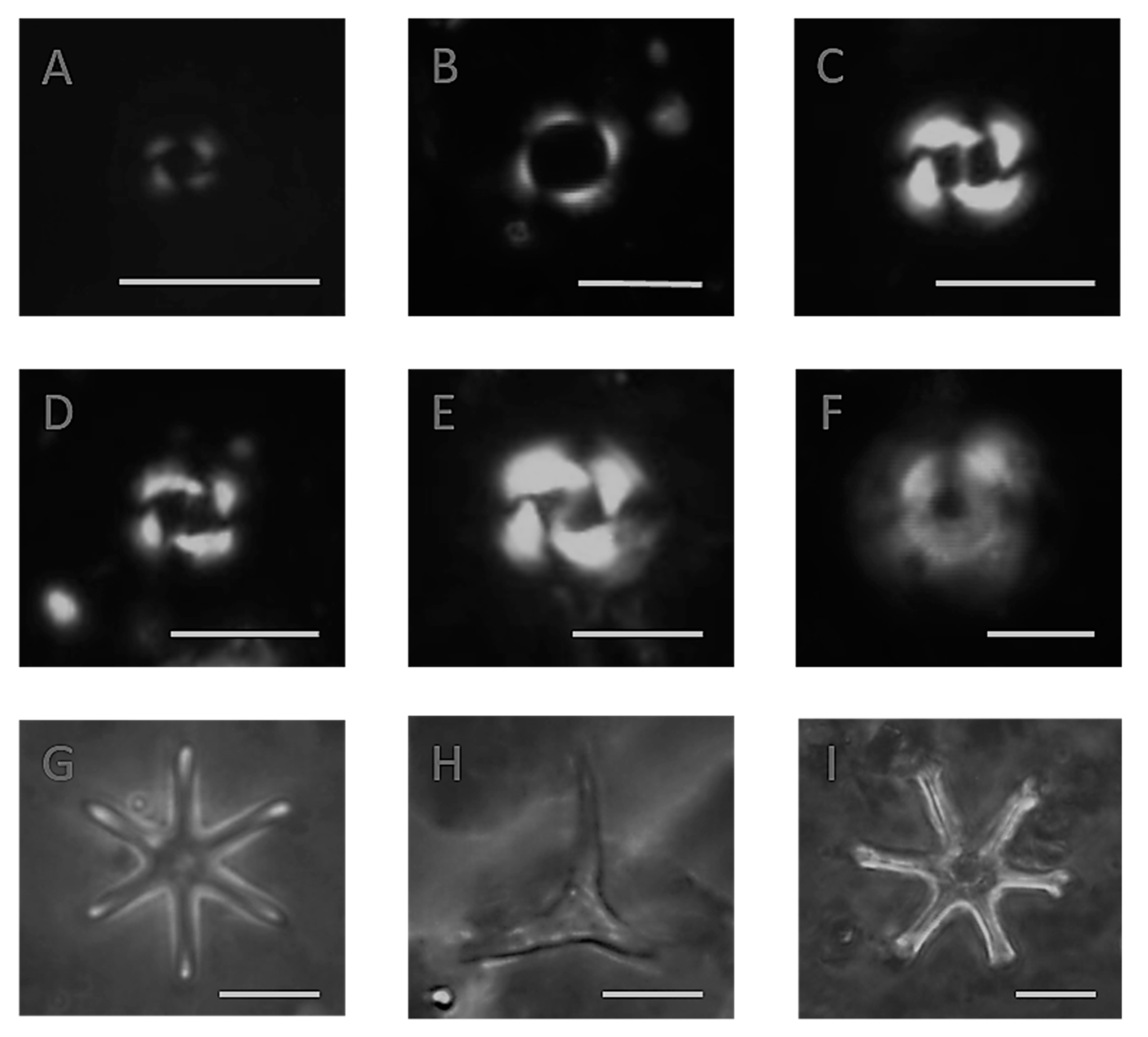
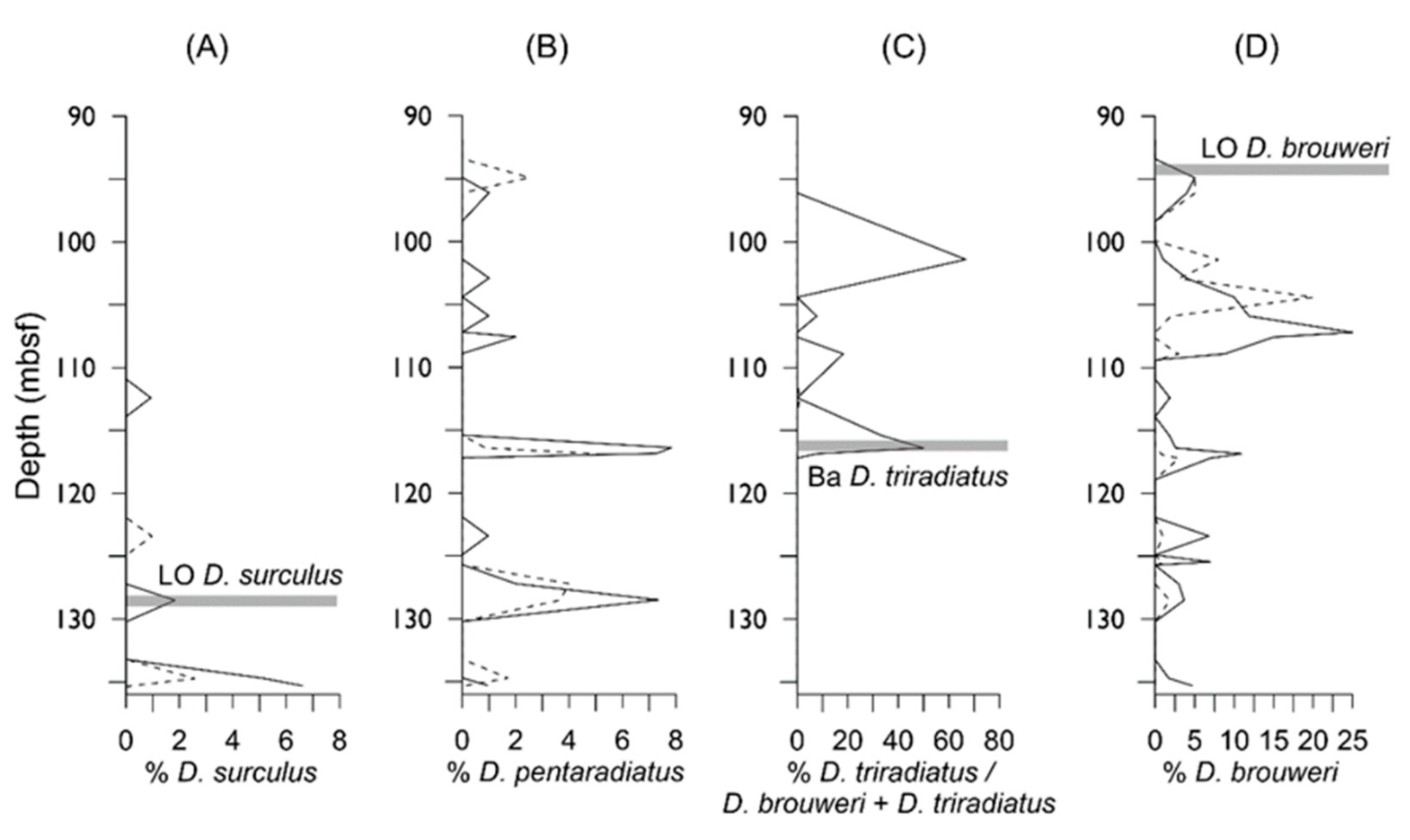
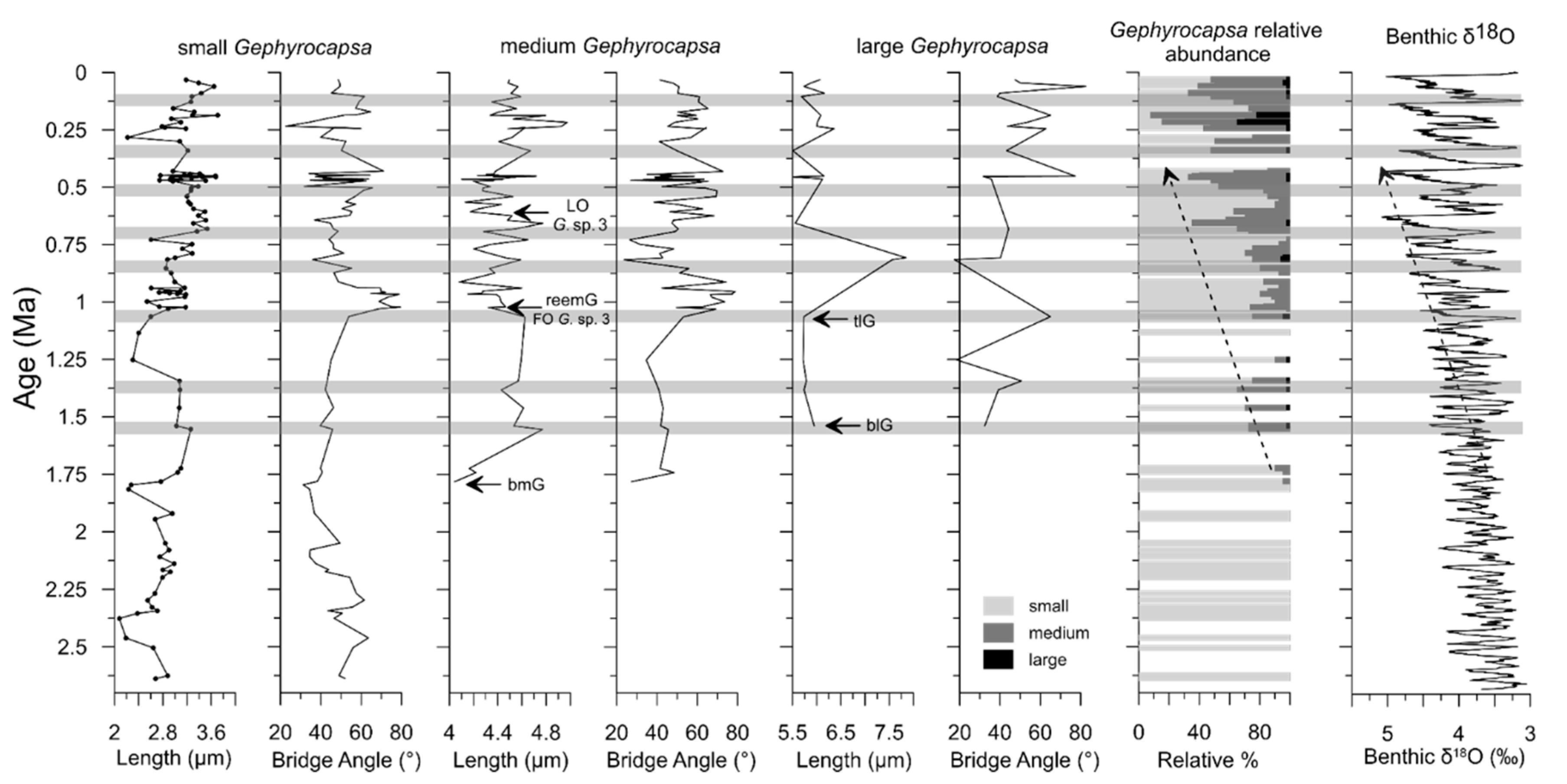
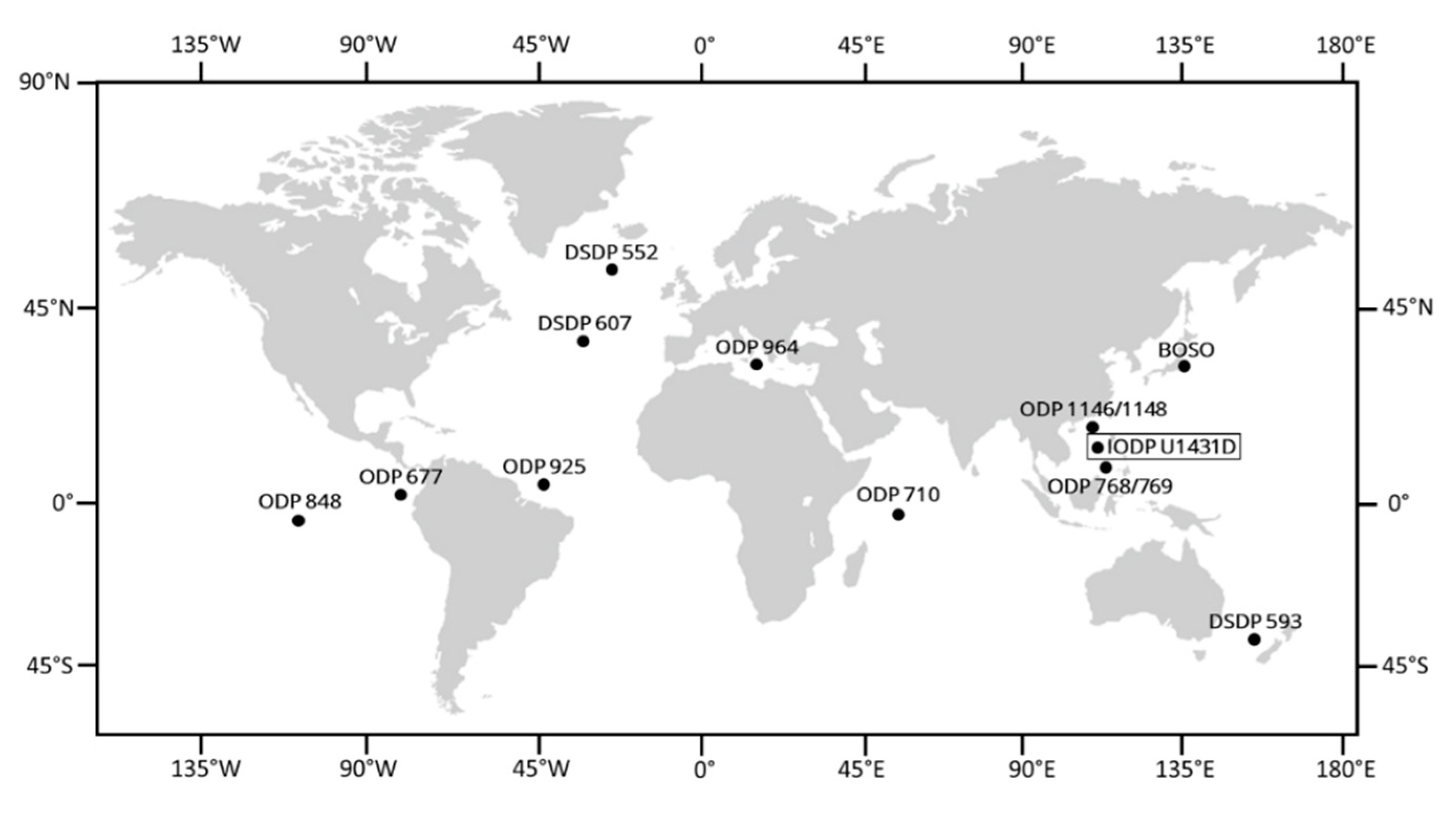
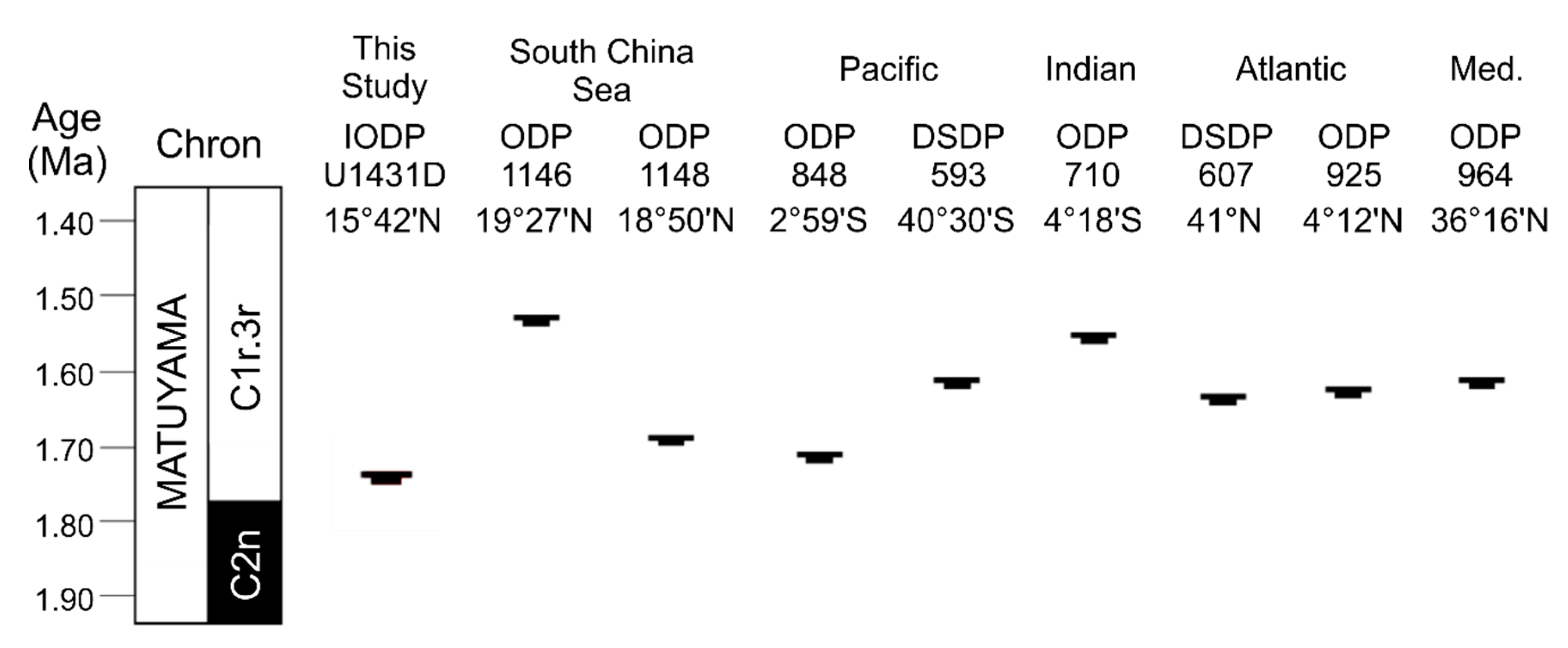

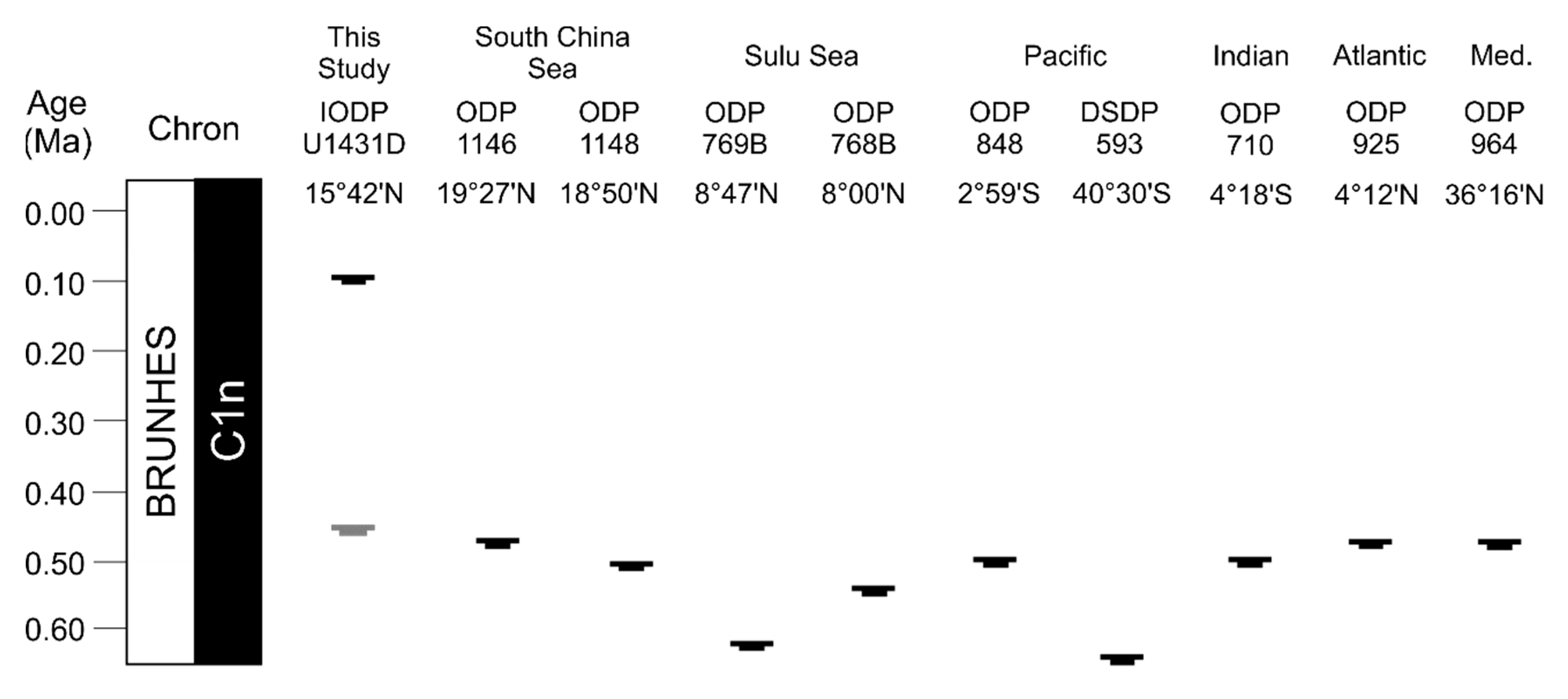
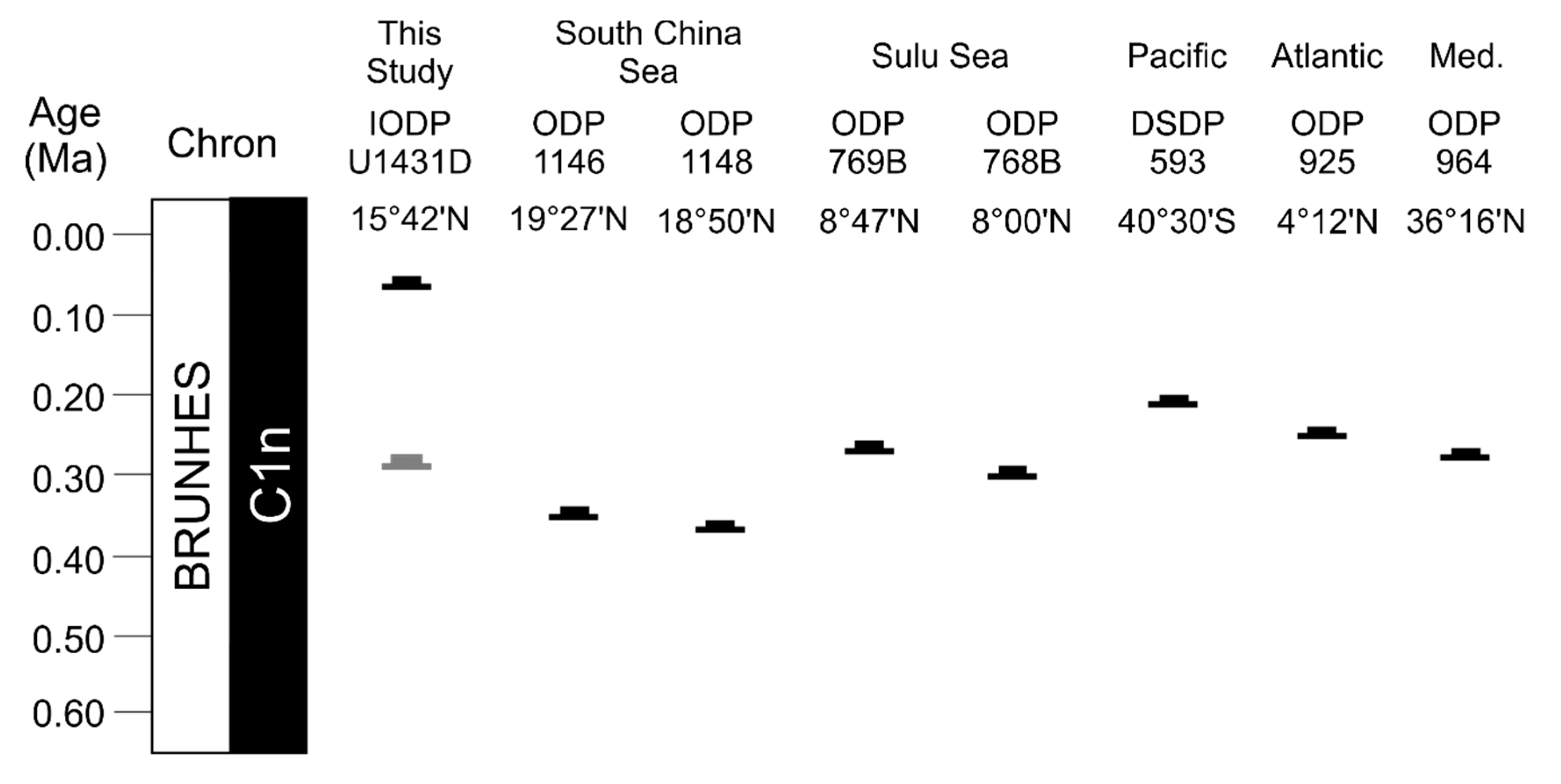
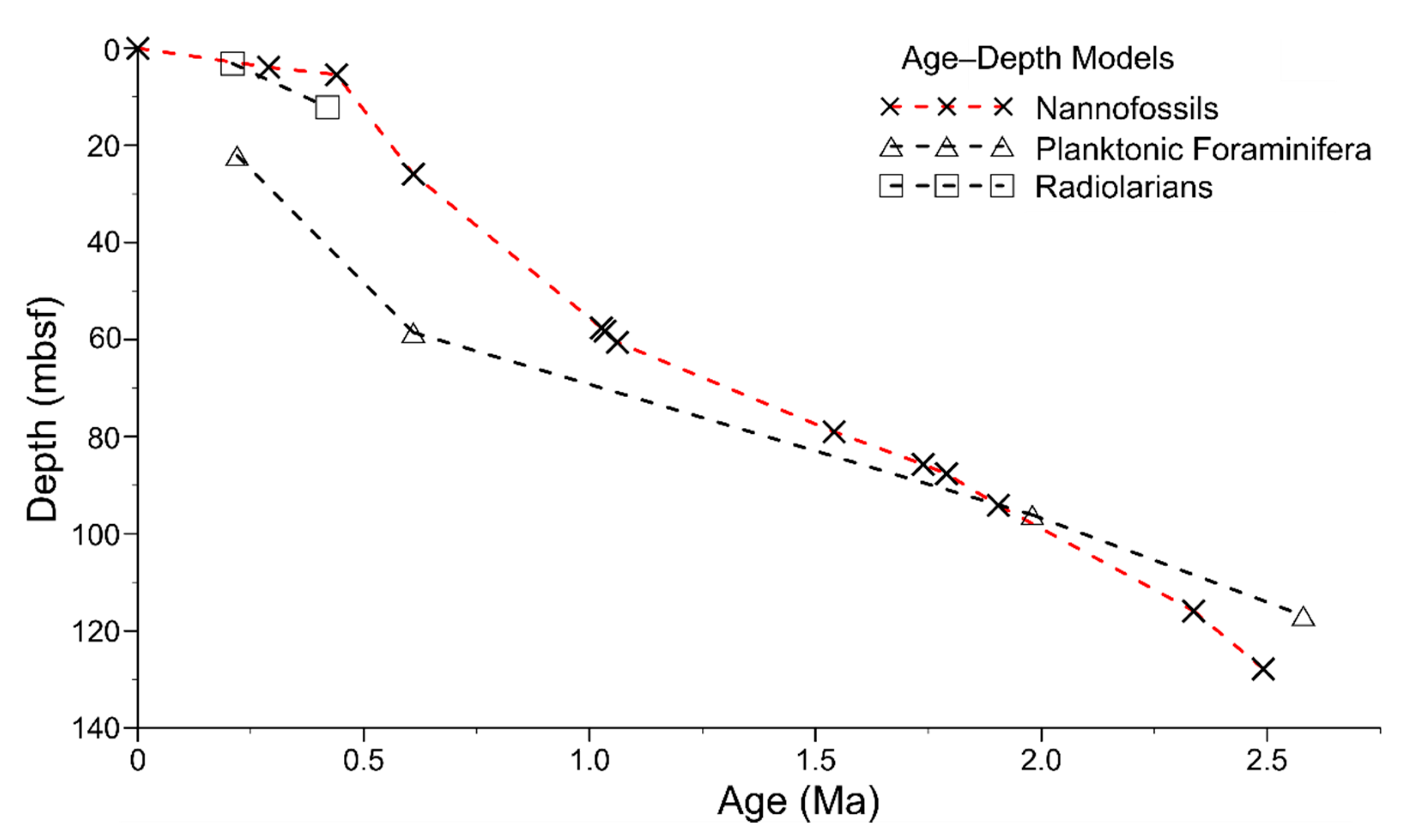

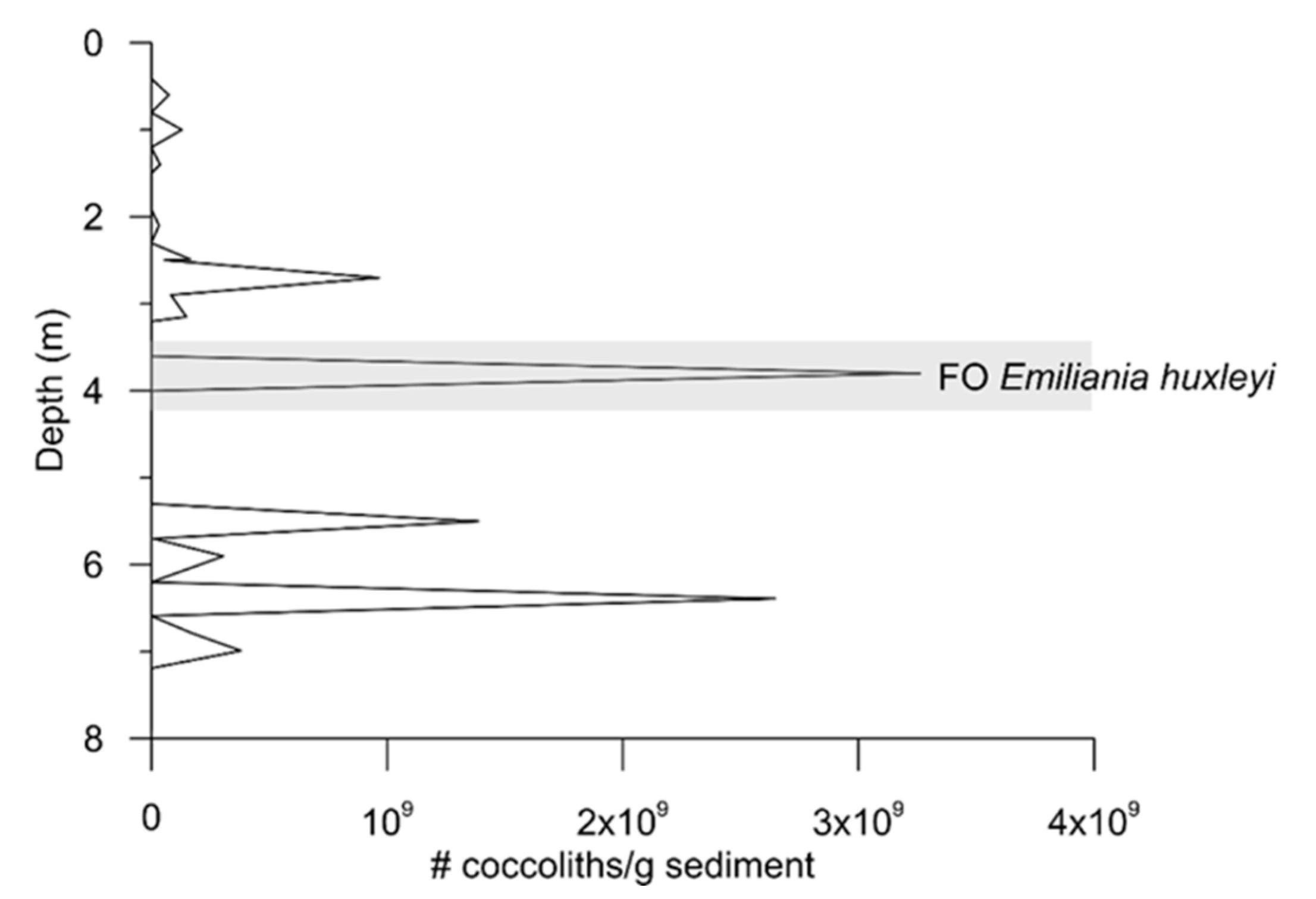
| IODP Expedition 349 Shipboard Results [43] | This Study | ||||
|---|---|---|---|---|---|
| Age (Ma) | Depth (mbsf) | Nannofossil Event | Age (Ma) | Depth (mbsf) | Nannofossil Event |
| 0.29 | 3.15 | FO Emiliania huxleyi | 0.29 | 3.905 | FO Emiliania huxleyi |
| 0.44 | 12.15 | LO Pseudoemiliania lacunosa | 0.44 | 5.42 | LO Pseudoemiliania lacunosa |
| 0.61 | 32.08 | LO Gephyrocapsa sp. 3 | 0.61 | 25.925 | LO Gephyrocapsa sp. 3 |
| 1.02 | 39.67 | FO Gephyrocapsa sp. 3 | 1.026 | 57.605 | FO Gephyrocapsa sp. 3 |
| 1.04 | 50.90 | reemG | 1.034 | 58.24 | reemG |
| 1.24 | 60.70 | tlG | 1.062 | 60.60 | tlG |
| 1.60 | 89.01 | LO Calcidiscus macintyrei | 1.541 | 78.985 | blG |
| 1.62 | 96.10 | blG | 1.738 | 85.705 | LO Calcidiscus macintyrei |
| 1.789 | 87.635 | bmG | |||
| 1.93 | 107.57 | LO Discoaster brouweri | 1.905 | 94.15 | LO Discoaster brouweri |
| 2.22 | 116.85 | Ba Discoaster triradiatus | 2.337 | 115.905 | Ba Discoaster triradiatus |
| 2.49 | 135.20 | LO Discoaster surculus | 2.491 | 127.855 | LO Discoaster surculus |
| Hole/Name | Latitude | Longitude | Water Depth (m) | Reference(s) |
|---|---|---|---|---|
| DSDP 552 | 56°02.56′ N | 23°13.88′ W | 2301 | [13,62] |
| DSDP 607 | 41°00.07′ N | 32°57.44′ W | 3427 | [21,22,63] |
| ODP 964 | 36°15.62′ N | 17°45.025′ E | 3650 | [64] |
| Boso Peninsula | 35° N | 140° E | - | [65] |
| ODP 1146 | 19°27.40′ N | 116°16.37′ E | 2092 | [42] |
| ODP 1148 | 18°50.17′ N | 116°33.93′ E | 3294 | [42,66] |
| ODP 769B | 8°47.12′ N | 121°17.68′ E | 3644 | [67] |
| ODP 768B | 8°00.05′ N | 121°13.19′ E | 4385 | [67] |
| ODP 925B | 4°12.25′ N | 43°29.35′ W | 3041 | [58] |
| ODP 677 | 1°12.03′ N | 83°44.16′ W | 3461 | [21,22] |
| ODP 848 | 2°59.6′ S | 110°28.8′ W | 3855 | [68] |
| ODP 710 | 4°18.7′ S | 60°58.8′ E | 3824 | [13,69] |
| DSDP 593 | 40°30.47′ S | 167°40.47′ E | 1068 | [70,71] |
© 2020 by the authors. Licensee MDPI, Basel, Switzerland. This article is an open access article distributed under the terms and conditions of the Creative Commons Attribution (CC BY) license (http://creativecommons.org/licenses/by/4.0/).
Share and Cite
Guballa, J.D.S.; Peleo-Alampay, A.M. Pleistocene Calcareous Nannofossil Biostratigraphy and Gephyrocapsid Occurrence in Site U1431D, IODP 349, South China Sea. Geosciences 2020, 10, 388. https://doi.org/10.3390/geosciences10100388
Guballa JDS, Peleo-Alampay AM. Pleistocene Calcareous Nannofossil Biostratigraphy and Gephyrocapsid Occurrence in Site U1431D, IODP 349, South China Sea. Geosciences. 2020; 10(10):388. https://doi.org/10.3390/geosciences10100388
Chicago/Turabian StyleGuballa, Jose Dominick S., and Alyssa M. Peleo-Alampay. 2020. "Pleistocene Calcareous Nannofossil Biostratigraphy and Gephyrocapsid Occurrence in Site U1431D, IODP 349, South China Sea" Geosciences 10, no. 10: 388. https://doi.org/10.3390/geosciences10100388
APA StyleGuballa, J. D. S., & Peleo-Alampay, A. M. (2020). Pleistocene Calcareous Nannofossil Biostratigraphy and Gephyrocapsid Occurrence in Site U1431D, IODP 349, South China Sea. Geosciences, 10(10), 388. https://doi.org/10.3390/geosciences10100388




